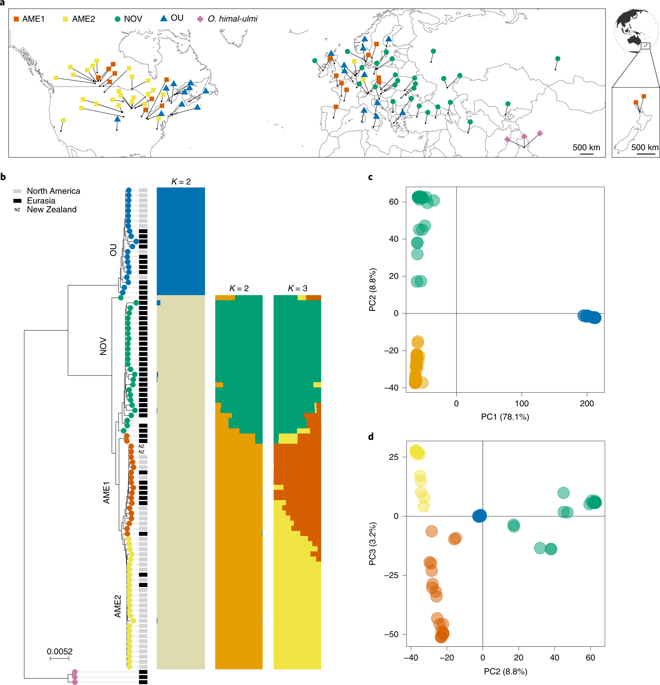当前位置:
X-MOL 学术
›
Nat. Ecol. Evol.
›
论文详情
Our official English website, www.x-mol.net, welcomes your
feedback! (Note: you will need to create a separate account there.)
Hybridization and introgression drive genome evolution of Dutch elm disease pathogens.
Nature Ecology & Evolution ( IF 13.9 ) Pub Date : 2020-03-02 , DOI: 10.1038/s41559-020-1133-6 Pauline Hessenauer 1, 2 , Anna Fijarczyk 2, 3, 4, 5 , Hélène Martin 2, 3, 4, 5 , Julien Prunier 1, 2, 6 , Guillaume Charron 2, 3, 4, 5 , Jérôme Chapuis 1, 2 , Louis Bernier 1, 2, 7 , Philippe Tanguay 8 , Richard C Hamelin 1, 2, 9 , Christian R Landry 2, 3, 4, 5, 10
Nature Ecology & Evolution ( IF 13.9 ) Pub Date : 2020-03-02 , DOI: 10.1038/s41559-020-1133-6 Pauline Hessenauer 1, 2 , Anna Fijarczyk 2, 3, 4, 5 , Hélène Martin 2, 3, 4, 5 , Julien Prunier 1, 2, 6 , Guillaume Charron 2, 3, 4, 5 , Jérôme Chapuis 1, 2 , Louis Bernier 1, 2, 7 , Philippe Tanguay 8 , Richard C Hamelin 1, 2, 9 , Christian R Landry 2, 3, 4, 5, 10
Affiliation

|
Hybridization and the resulting introgression can drive the success of invasive species via the rapid acquisition of adaptive traits. The Dutch elm disease pandemics in the past 100 years were caused by three fungal lineages with permeable reproductive barriers: Ophiostoma ulmi, Ophiostoma novo-ulmi subspecies novo-ulmi and Ophiostoma novo-ulmi subspecies americana. Using whole-genome sequences and growth phenotyping of a worldwide collection of isolates, we show that introgression has been the main driver of genomic diversity and that it impacted fitness-related traits. Introgressions contain genes involved in host-pathogen interactions and reproduction. Introgressed isolates have enhanced growth rate at high temperature and produce different necrosis sizes on an in vivo model for pathogenicity. In addition, lineages diverge in many pathogenicity-associated genes and exhibit differential mycelial growth in the presence of a proxy of a host defence compound, implying an important role of host trees in the molecular and functional differentiation of these pathogens.
中文翻译:

杂交和基因渗入驱动荷兰榆病病原体的基因组进化。
杂交和由此引起的基因渗入可以通过快速获得适应性状来驱动入侵物种的成功。在过去的100年中,荷兰榆病大流行是由三个具有可渗透的生殖屏障的真菌谱系引起的:ulphiostoma ulmi,ophiostoma novo-ulmi亚种novo-ulmi和ophiostoma novo-ulmi亚种。使用全基因组序列和全球分离株集合的生长表型,我们证明基因渗入一直是基因组多样性的主要驱动力,并且影响了健身相关性状。渗入包含与宿主-病原体相互作用和繁殖有关的基因。渗入的分离物在高温下具有提高的生长速率,并且在致病性的体内模型上产生不同的坏死大小。此外,
更新日期:2020-04-24
中文翻译:

杂交和基因渗入驱动荷兰榆病病原体的基因组进化。
杂交和由此引起的基因渗入可以通过快速获得适应性状来驱动入侵物种的成功。在过去的100年中,荷兰榆病大流行是由三个具有可渗透的生殖屏障的真菌谱系引起的:ulphiostoma ulmi,ophiostoma novo-ulmi亚种novo-ulmi和ophiostoma novo-ulmi亚种。使用全基因组序列和全球分离株集合的生长表型,我们证明基因渗入一直是基因组多样性的主要驱动力,并且影响了健身相关性状。渗入包含与宿主-病原体相互作用和繁殖有关的基因。渗入的分离物在高温下具有提高的生长速率,并且在致病性的体内模型上产生不同的坏死大小。此外,











































 京公网安备 11010802027423号
京公网安备 11010802027423号